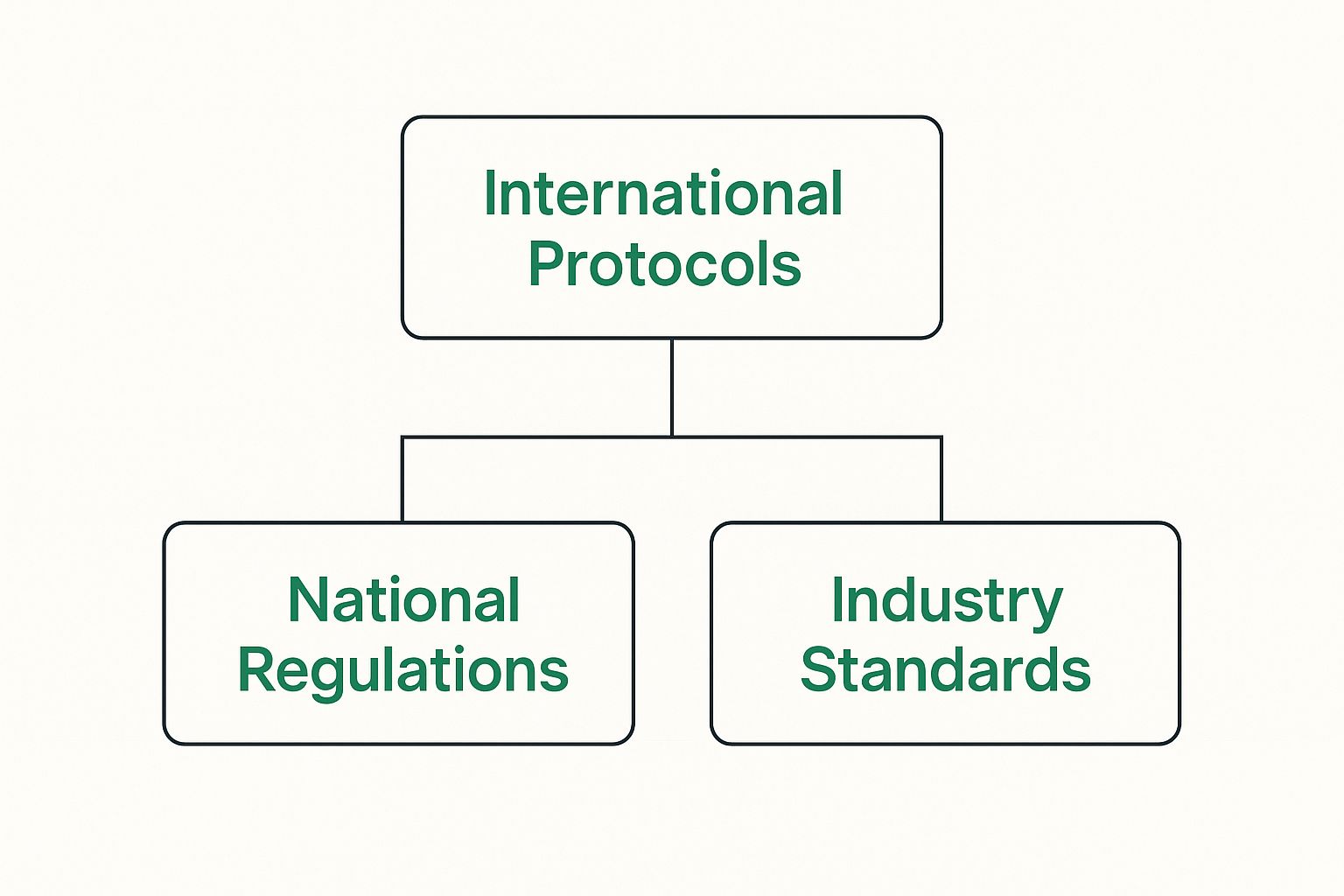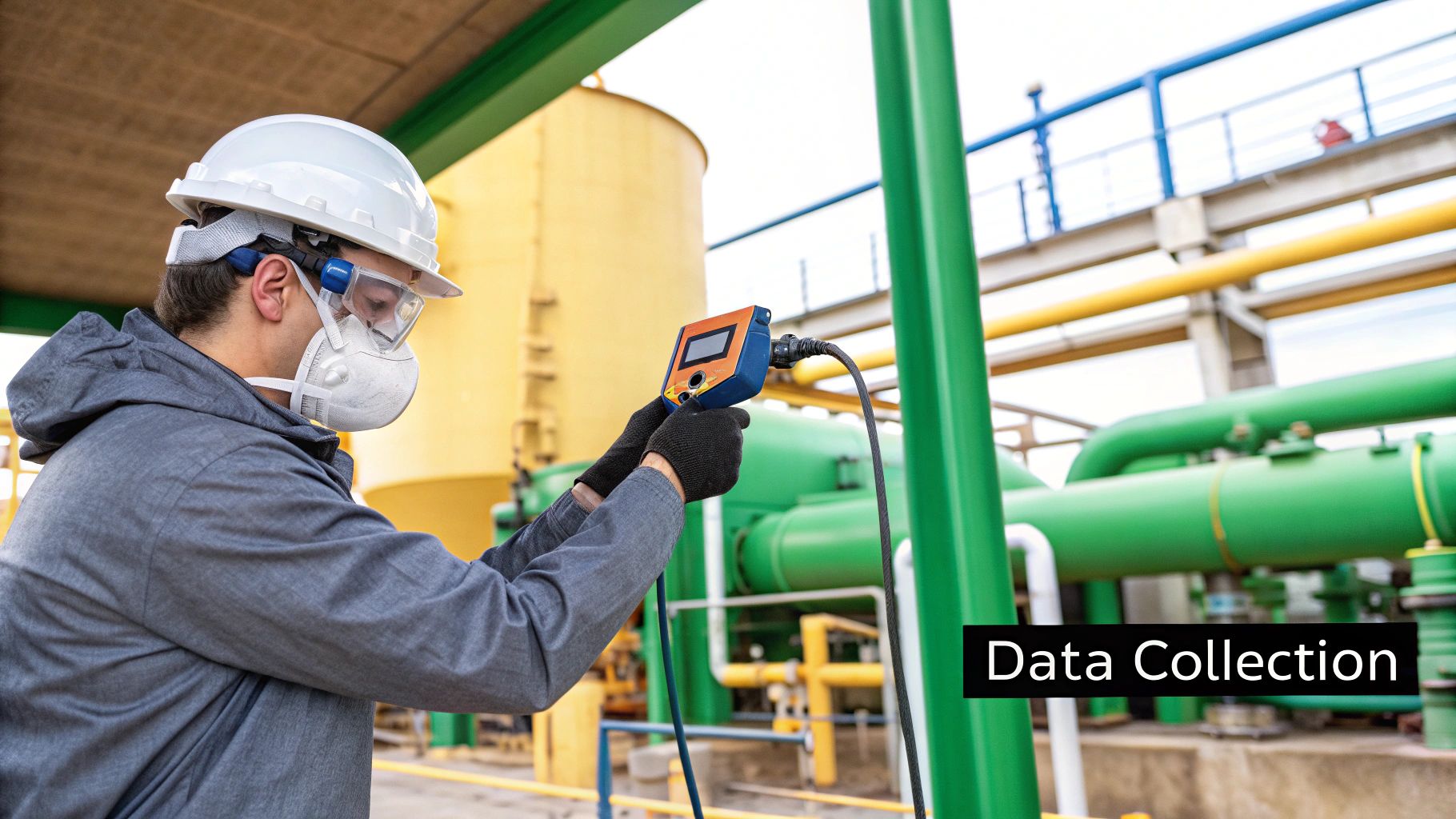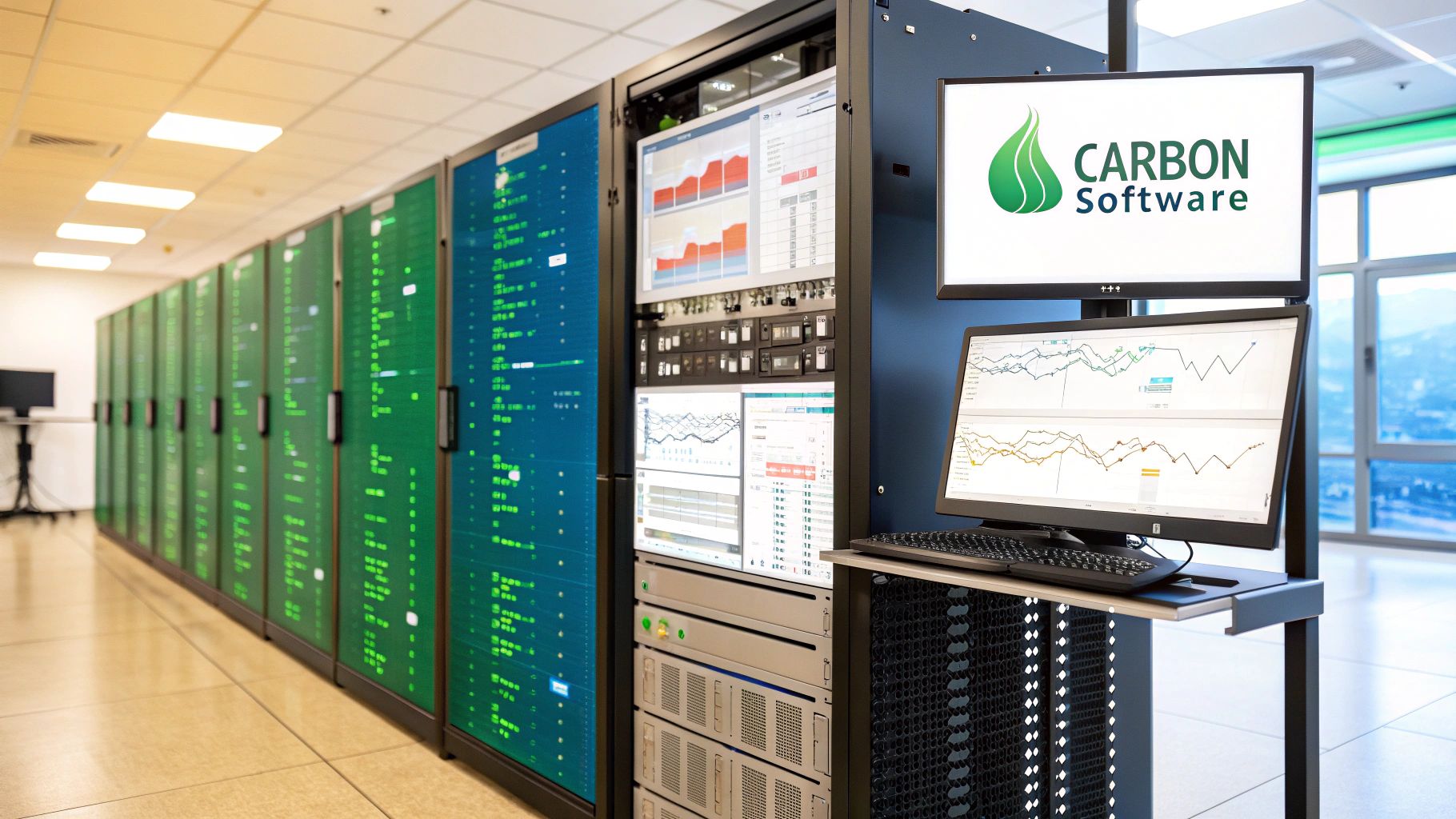Regulatory Compliance Carbon Tracking Guide for the Czech Republic
Karel Maly
July 27, 2025
At its most basic level, regulatory compliance carbon tracking is the system businesses must follow to measure and report their greenhouse gas emissions according to government rules. It’s a lot like financial accounting. But instead of tracking euros or crowns, you’re counting tonnes of CO2.
Understanding Carbon Compliance Tracking

Diving into the world of carbon emissions can feel a bit overwhelming, but the core idea is straightforward. Governments, especially within the European Union, have set ambitious targets to tackle climate change. To make sure these goals are actually met, they need businesses to keep a careful record of their environmental footprint. This is more than just a box-ticking exercise; it represents a real shift in what corporate accountability looks like.
For companies operating in the Czech Republic, this process has become more and more defined over the years. Since joining the EU, our national environmental laws have been brought into line with wider European directives. The Pre-Accession Period (1999-2003) was particularly crucial, as it saw major updates to our legal frameworks on pollution control and access to environmental information. For a deeper dive, you can explore the evolution of Czech environmental policy on cenia.gov.cz.
More Than Just a Mandate
It's a mistake to see regulatory carbon tracking as just another obligation. Of course, failing to comply can bring hefty fines and hurt your reputation. But getting a handle on this process can also open up some significant strategic doors. It essentially forces you to take a magnifying glass to your entire operation, from the electricity you use to the logistics of your supply chain.
This kind of detailed operational view almost always shines a light on hidden inefficiencies. When you track your carbon, you're also tracking your resource use. This points you directly to opportunities for reducing waste and, ultimately, cutting your costs.
Approaching it this way turns a regulatory burden into a smart business tool. You move from a purely defensive, "just stay compliant" mindset to an offensive strategy that actively drives improvement.
The Core Pillars of Carbon Compliance
To build a carbon tracking system that is both effective and compliant, you need to focus on a few key components. These pillars are the foundation of any trustworthy programme, ensuring everything you report is accurate, transparent, and stands up to scrutiny. They are the bedrock of good practice.
Here's a breakdown of what these pillars mean for your business:
| Pillar | Description | Business Implication |
|---|---|---|
| Measurement | Accurately calculating greenhouse gas emissions from all sources your company controls or influences, including your entire value chain. | You need reliable data collection methods to get a true picture of your footprint, which is the starting point for any reduction strategy. |
| Reporting | Presenting your emissions data in a standardised format that meets the specific guidelines of the relevant authority (e.g., EU ETS, CSRD). | Clear, consistent reporting demonstrates transparency and makes your data comparable and understandable to regulators and investors. |
| Verification | Having an independent, third-party auditor review and confirm that your reported data is accurate, complete, and follows the rules. | Third-party verification builds credibility and trust, giving your stakeholders confidence that your numbers are legitimate. |
Mastering these three pillars isn’t just about staying on the right side of the law. It’s about building genuine trust with everyone who has a stake in your business—from investors and customers to the regulators themselves.
Navigating the Key Carbon Reporting Frameworks
For any Czech business stepping into regulatory compliance carbon tracking, the landscape can feel like a thicket of confusing acronyms. You'll hear about the EU ETS, CSRD, and GHG Protocol, and while they all seem related, figuring out how they connect is the first real challenge. Think of it like learning a language: you need to grasp the core grammar before you can speak fluently in different dialects.
This isn't just about ticking boxes. It’s about understanding a system where international standards lay the groundwork for national laws and industry-specific requirements.

As you can see, global best practices—like the GHG Protocol—are the foundation. They directly shape the mandatory government rules and voluntary reporting platforms that businesses actually use day-to-day.
The GHG Protocol: The Universal Language of Carbon Accounting
Almost every serious carbon reporting effort, whether mandatory or voluntary, is built on the Greenhouse Gas (GHG) Protocol. It's not a law itself, but rather the world's most accepted accounting standard. It’s the "grammar" everyone has agreed to use for measuring and managing greenhouse gas emissions, providing the rulebook that other frameworks build upon.
The Protocol's most important concept is splitting emissions into three categories, or "scopes":
- Scope 1: These are your direct emissions. Think of the fuel burned in your company's vehicles or furnaces, or emissions from chemical processes right at your facility. You own and control these sources directly.
- Scope 2: These are indirect emissions from the energy you buy. The classic example is the electricity you purchase from the grid to light your offices, run your machines, and power your servers.
- Scope 3: This is the big one. It covers all other indirect emissions up and down your company's value chain. This means emissions from your suppliers, the transportation and distribution of your goods, and even what happens when your customers use your products. For many businesses, especially in sectors like logistics, this is where the bulk of their footprint lies.
To dig deeper into this, particularly for value chain emissions, we've put together a dedicated guide on carbon footprint tracking in logistics for Czech businesses.
Mandatory EU Frameworks for Czech Businesses
With the GHG Protocol providing the "how-to," specific EU regulations define who must report and what they must report. For businesses operating in the Czech Republic, two major directives lead the way:
-
EU Emissions Trading System (EU ETS): This is a classic "cap and trade" system. It mainly targets large, energy-intensive installations like power stations, refineries, and heavy industrial plants. Companies covered by the EU ETS have a cap on their emissions, must report them every year, and have to turn in enough "emission allowances" to cover what they've emitted.
-
Corporate Sustainability Reporting Directive (CSRD): The CSRD casts a much wider net. It's not just for heavy industry; it requires all large companies and listed SMEs to report on a whole range of environmental and social impacts. A huge piece of this is reporting on their full carbon footprint, using the GHG Protocol's scope-based method.
The CSRD is a game-changer for corporate reporting. It forces companies to look far beyond their own factory gates and report on their entire value chain. This makes getting a handle on Scope 3 emissions—and having a solid system for regulatory compliance carbon tracking—an absolute necessity.
How to Collect Accurate Carbon Data

When it comes to regulatory compliance carbon tracking, everything hinges on one thing: good data. Without accurate, trustworthy information, your final report is just a well-intentioned guess. The real goal is to get away from rough estimates and move towards precise measurement, which starts with knowing exactly what information you need and where to find it.
Think of it like creating a detailed map of your company’s energy use. You need to pinpoint every single spot where energy is consumed and emissions are produced. This could be anything from the boiler running in the basement to the logistics partner hauling your products across Europe.
This first step demands a methodical, organised approach. You’ll start with your most direct emissions and gradually work your way outwards to your broader value chain.
Mapping Your Emission Sources
Before you can even think about collecting numbers, you have to identify what to collect in the first place. This means building an "emissions inventory" by systematically mapping all your business activities against the three scopes defined by the GHG Protocol.
-
Scope 1 (Direct Emissions): This is the most straightforward category. It covers things like fuel burned by your company’s fleet of vehicles or emissions from any manufacturing processes you run on-site. Installing fuel monitoring systems is a great example of how you can get the solid consumption data needed for Scope 1.
-
Scope 2 (Indirect Emissions): This one is almost entirely about the energy you buy. Your task here is to round up every bill for electricity, heating, and cooling from your utility providers. These documents give you the raw numbers—the kilowatt-hours (kWh) or gigajoules (GJ)—that form the basis of your calculations.
-
Scope 3 (Value Chain Emissions): Here’s where things get tricky. Scope 3 covers a vast range of indirect activities, from the carbon footprint of your suppliers to your employees' daily commutes. The key is to start by focusing on the biggest hitters, like the goods and services you purchase or your transportation and distribution networks.
Key Insight: Start small and be systematic. Nail down your Scope 1 and 2 data first. Getting this right builds momentum and helps you establish solid internal processes that you can later expand to tackle the more complex world of Scope 3.
Gathering and Validating Your Data
With your sources mapped out, it’s time to gather the actual activity data. This means collecting tangible figures—litres of fuel used, kilometres driven, or kilograms of raw materials bought.
This is very much a team effort. Your finance department holds the utility bills, the fleet manager has the fuel logs, and the procurement team knows the supplier spending. It’s absolutely crucial to set up a central place for all this information, whether that’s a dedicated software platform or just a meticulously organised shared drive. This prevents data from getting lost in different departmental silos.
The importance of this kind of organised data tracking has been recognised at a national level for decades. For example, The National Programme to Abate Climate Change Impacts in the Czech Republic set ambitious targets like a 30% reduction in CO2 emissions per capita by 2020. Goals like these pushed businesses across all sectors to get better at tracking their data to measure progress.
Finally, always validate what you collect. Look for obvious errors, question any strange outliers, and compare new data against historical figures to catch inconsistencies. A little bit of quality control at this stage can save you a world of headaches when it comes time for reporting and auditing.
Best Practices for Compliant Carbon Reporting
So, you’ve done the hard work of collecting your emissions data. That’s a huge step, but it’s only half the battle. Reporting that data correctly is what truly matters for compliance and building trust with everyone from regulators to your own customers. To do this right, you need to create a carbon report that is transparent, accurate, and completely verifiable. It’s not just about spitting out numbers; it’s about telling a clear story with your data.
Think of it like getting your financial accounts ready for an audit. Every single number needs a solid paper trail. You have to be meticulous. Document your methods, be upfront about any assumptions you’ve made (especially for those tricky Scope 3 emissions), and make sure every calculation can be easily traced back to its source. This creates a rock-solid audit trail that will stand up to even the toughest scrutiny.
It’s also crucial to remember that reporting isn't one-size-fits-all. A submission for the EU ETS has totally different formatting and data requirements than, say, a voluntary disclosure to an organisation like the CDP. Knowing these nuances is what makes regulatory compliance carbon tracking efficient instead of a nightmare.
Building a Transparent and Verifiable Report
Transparency is the bedrock of any report that people will actually trust. It’s not just about shouting about your wins; it's about being honest about your challenges and the limitations of your data, too. Believe it or not, this kind of honesty actually makes you look more credible, not less.
This is especially important in a national context. Under the EU Effort Sharing Regulation, for instance, Czechia has a binding target to cut its GHG emissions by 26% by 2030, compared to 2005 levels. This national goal puts real pressure on businesses to do their part, and transparent reporting is how you prove you're pulling your weight. In fact, 2023 projections show a serious gap in meeting related land use targets, which puts even more emphasis on the need for rigorous tracking from the corporate sector. You can dig deeper into Czechia’s climate progress and targets on the official EU climate portal.
To make sure your report hits the mark on both transparency and verifiability, stick to these core principles:
- Document Everything: Keep detailed, organised records of all your data sources, the calculation methods you used, and any emission factors applied.
- Be Clear on Scope: Explicitly define the organisational and operational boundaries of your report. State exactly which facilities, operations, and emission scopes are included.
- Explain Your Assumptions: If you had to use estimates or industry averages (which is very common for Scope 3), explain why and show how you arrived at those figures.
Crafting a Narrative for Stakeholder Trust
Your carbon report is much more than a box-ticking exercise for regulators. It's a powerful communication tool. The numbers tell one part of the story, but the narrative you weave around them is what truly connects with stakeholders and shows you have a real strategy.
A great carbon report doesn’t just state emissions figures. It explains what those figures mean, details the actions being taken to reduce them, and outlines future goals. This transforms your report from a static snapshot into a dynamic roadmap for improvement.
Use your report to put your reduction strategies and successes in the spotlight. This narrative builds confidence with investors, customers, and regulators by showing them you're actively and intelligently managing your environmental footprint. Of course, having the right tools makes this infinitely easier. Our guide on the best carbon compliance software is a great resource for finding platforms designed to simplify this complex reporting process.
Using Technology for Better Carbon Management

Trying to manage your company's carbon footprint with manual spreadsheets is a bit like navigating a supertanker with a pocket compass. You might get there eventually, but it’s going to be slow, riddled with mistakes, and you’ll have no real strategic awareness of the journey. Technology is completely changing the game, turning what was once a compliance chore into a genuine source of business intelligence.
This isn't just a minor improvement; it's a fundamental shift. Specialised carbon management platforms help companies leave behind the chaotic world of disconnected spreadsheets. These systems automate the entire process—from gathering data to producing reports ready for audit—which guarantees accuracy and frees up hundreds of hours of manual effort.
Automating for Accuracy and Efficiency
At its core, carbon management software is designed to bring order to data chaos. These platforms are built specifically to handle the immense complexity of emissions tracking by automating the tedious, repetitive tasks that are so easy to get wrong. This isn't just about speed; it's about achieving a level of precision that is absolutely critical for compliance.
Think about what gets automated:
- Centralised Data Collection: Instead of manual entry, the system automatically pulls data from utility bills, fuel cards, and even supplier platforms.
- Accurate Calculations: It applies the latest, scientifically-backed emission factors to all your activity data, ensuring your figures are fully compliant with the GHG Protocol.
- Streamlined Reporting: It generates reports formatted perfectly for specific standards like CSRD or CDP, often with just a few clicks.
Once you have this automation in place, you can start looking at more advanced compliance strategies. To see just how far this can go, have a look at our guide on https://www.carbonpunk.ai/en/blog/automated-sustainability-reports-for-esg-compliance.
Finding Strategic Insights with AI
The best platforms don't stop at simple automation. They integrate artificial intelligence (AI) to analyse sprawling, complex datasets, uncovering patterns and opportunities that a human analyst could easily miss. Suddenly, your carbon data transforms from a reporting requirement into a powerful tool for making smart business decisions.
AI doesn't just calculate your past emissions; it helps you actively design a better future. By forecasting your footprint based on business plans and pinpointing hidden hotspots, it gives you a clear roadmap for making changes that are both impactful and cost-effective.
This intelligence isn’t just for your sustainability team, either. Advanced tools, such as an AI-powered Finance Compliance Advisor, can help you navigate a wide range of regulatory demands, including those tied to carbon. In sustainability, AI can identify which suppliers carry the most risk in your value chain or model the financial savings of switching to lower-emission logistics. It’s this proactive thinking that keeps a business resilient, competitive, and one step ahead of tomorrow’s regulations.
Here is the rewritten section, crafted to sound human-written and expert-led.
Turning Carbon Compliance Into Business Value
Many companies see carbon reporting as just another box to tick for the regulators. That’s a huge mistake. The real goal isn't just about meeting your legal obligations; it's about turning that compliance work into a tool that makes your business stronger and more competitive. If you only see it as a cost, you're missing the opportunity hidden within the data.
Think of it this way: a detailed carbon footprint analysis is basically a roadmap to your company's efficiency. Every single tonne of CO₂ you account for is tied to something real – energy you paid for, materials you bought, or waste you had to manage. When you find an emissions hotspot, you've also found a place to cut energy bills, tighten up your logistics, or reduce material waste. Suddenly, compliance stops being a cost centre and starts driving real operational improvements and savings.
From Obligation to Opportunity
The benefits don't just stay inside your company walls. Solid, transparent carbon reporting is a massive advantage in the open market. More and more, customers care about sustainability, and being able to prove your green credentials can be the very thing that makes them choose you over a competitor. It builds a brand that people trust.
It's also worth remembering that the data you collect for compliance is precisely what modern investors are looking for. Investors focused on ESG (Environmental, Social, and Governance) criteria actively search for businesses with clear, verifiable sustainability plans. They see strong environmental performance not just as a "nice-to-have," but as a sign of smart, low-risk, long-term management.
Building a More Resilient Business
At the end of the day, using your compliance data smartly builds a more durable business. It gets you ready for whatever regulations come next, protecting you from the financial hit of future carbon taxes or even tougher reporting rules. When you truly understand the carbon impact of your entire value chain, you can choose better suppliers and build a supply chain that's less vulnerable to climate-related problems.
Companies that get this right find it sparks innovation everywhere. They're better positioned to create low-carbon products, tap into new green markets, and build the kind of reputation that attracts the best talent. By treating compliance as a strategic part of the business, you're not just managing risk—you're laying the groundwork for success that will last.
Common Carbon Tracking Questions Answered
Jumping into regulatory carbon tracking for the first time can feel a bit like learning a new language. There are new terms, new rules, and a lot of data to handle. It’s completely normal to have questions. Let's break down some of the most common ones to give you a clear path forward.
What Are the First Steps for a Small Business?
If you're a small business, don't try to boil the ocean. The best place to start is right at home, focusing on what you directly control. First, figure out which regulations actually apply to your business size and industry – you might not be subject to any mandatory reporting just yet.
Then, concentrate on your Scope 1 emissions (like fuel for company cars) and Scope 2 emissions (the electricity you buy for your office or workshop). Simply gathering your utility bills and fuel receipts is a fantastic first step. This creates a solid baseline of data long before you need to worry about the complexities of your supply chain.
How Often Must We Report Emissions?
This really depends on the specific rules you're following. There isn't a single answer for everyone.
- Mandatory Schemes: If you fall under a framework like the EU ETS, you’re typically looking at an annual reporting requirement.
- Voluntary Disclosures: Platforms like CDP also run on a yearly cycle for companies choosing to disclose their data.
A word of advice from experience: track your data continuously. If you monitor your emissions throughout the year, the official annual report becomes a simple summary rather than a frantic, stressful scramble for twelve months of forgotten data.
What Is the Biggest Challenge in Scope 3 Tracking?
Without a doubt, the biggest headache with Scope 3 is getting good data. These are the emissions from sources you don't own or control, like your suppliers, logistics partners, and even your customers' use of your products. Trying to get reliable emissions figures from hundreds of different partners is a massive undertaking.
So, how do you start? Don’t let perfect be the enemy of good. The accepted approach is to begin with estimations using industry-average data for your specific purchasing categories. From there, you can gradually improve your accuracy over time by engaging directly with key suppliers to get their actual data.
Ready to move beyond spreadsheets and streamline your compliance? The Carbonpunk AI-driven platform automates data collection, ensures over 95% accuracy, and generates audit-ready reports, turning your regulatory obligations into a competitive advantage. Discover how Carbonpunk can help your business.